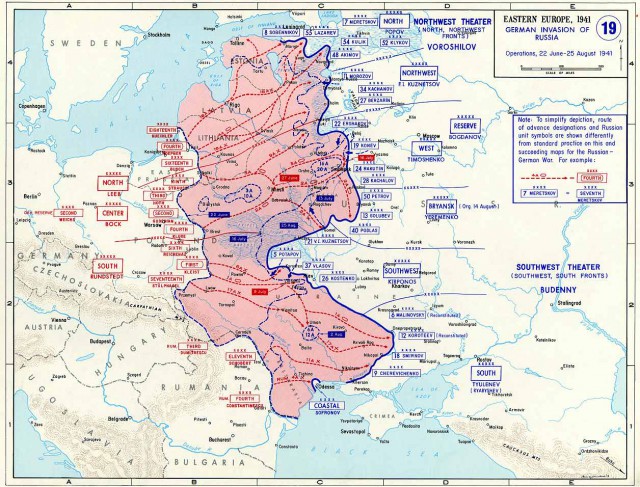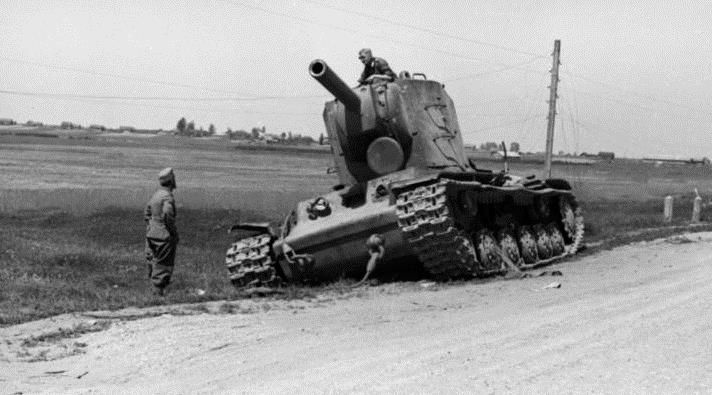On June 22, 1941, Germany and the Axis powers commenced Operation Barbarossa, the invasion of the Soviet Union along a 2,900 km front with a force of some four million soldiers, the largest invasion force in history. In the Baltic states, Army Group North swept through the Soviet defenses in a matter of days and by early July, the Soviet army had withdrawn to the Stalin line, praying they could stop the rapid German advance to Leningrad.
The Russian’s Northwestern front was a costly disaster, both in lives and equipment. But in these few days of fast devastation and retreat, there is a story of the crew in one lone Russian KV tank that held back the Kampfgruppe Raus of the 6th Panzer division for a bold and precious full day. It was a remarkable, defiant stand against the German war machine.
The Battle of Raseiniai, from June 22nd to June 27th, was fought for control of strategic river crossings in Lithuania over the Neman (Nemunas) and Dubysa Rivers near the village of Raseiniai and the city of Kaunas. Well, in truth, this was a battle of the Russians trying desperately to put together any kind of effective counterattack against the Germans who had secured such river crossings by the end of the first day.

This was a battle of tanks. The Germans sent in 245 tanks against the Russians 749. And it might be hard to imagine that the Germans could overcome such odds before the role of the Luftwaffe’s Luftflotte 1 is considered.
Luftflotte 1’s aerial assault at the beginning of Operation Barbarossa took out a huge portion of Soviet communications as the ground troops moved in. This helped contribute to a huge lack of coordination of accurate information for the Russian forces. In one instance during the Battle of Raseiniai, Russian tanks attacked what they thought was the German flank, but was, in fact, the full front of the advancing Reich.
Had it not been for Luftflotte 1, the Germans might never have overcome their greatest obstacle in the Russian Mechanized Corps: the KV-1 and KV-2, Russian heavy tanks.
The German’s Panzer 35(t) didn’t have guns that could penetrate the thick armor of these Russian beasts and nor could their 37mm antitank guns. Even when the KVs were out of ammo, they sometimes just drove up and ran over the German antitank guns. When the Luftwaffe was unavailable for bomber support, 88mm anti-aircraft guns and sticky bombs placed on the tracks of the tanks were all that managed to take the Russian beasts down.
Here is a recounting of a skirmish the 1st Panzer Division had with KV tanks on June 23rd:
The KV-1 & KV-2, which we first met here, were really something! Our companies opened fire at about 800 yards, but it remained ineffective. We moved closer and closer to the enemy, who for his part continued to approach us unconcerned. Very soon we were facing each other at 50 to 100 yards. A fantastic exchange of fire took place without any visible German success. The Russian (sic – Soviet) tanks continued to advance, and all armour-piercing shells simply bounced off them.
Thus we were presently faced with the alarming situation of the Russian (sic) tanks driving through the ranks of 1st Panzer Regiment towards our own infantry and our hinterland. Our Panzer Regiment therefore about turned and rumbled back with the KV-1s and KV-2s, roughly in line with them. In the course of that operation we succeeded in immobilizing some of them with special purpose shells at very close range 30 to 60 yards. A counter attack was launched and the Russians (sic – Soviets) were thrown back. A protective front established & defensive fighting continued.
-From Hitler Moves East by Paul Carrell

By the morning of June 24th, German forces controlled much of the area West of Kaunas. Is was on this morning that a convoy from Kampfgruppe Raus, moving captured Soviets and wounded Germans from the front line on the Eastern side of the Dubysa, back towards Raseiniai, spotted a lone KV tank at a crossroads outside of the little village.
The KV opened fire. The convoy promptly turned around. The 6th Panzer division had been expecting another counterattack, perhaps this was the beginning of it. But tales from locals recall that this single tank had simply driven up to its location the night before and stopped, waited.
While Generaloberst Erhard Raus (commander of the Kampfgruppe which bore his name) sorted out what kind of fearsome attack the Russians were mounting between his forces and division headquarters back West, a convoy bringing his troops fuel and ammunition approached the KV’s crossroads. The KV opened fire and destroyed it, leaving twelve trucks burning.
Raus figured out it was only one tank. Supplies were needed, the wounded were suffering, this tank had to be removed. But it continued to sit there, firing shots at the Germans in Raseiniai. 50mm anti-tank guns were positioned in a battery, fired, but still the tank remained. After several minutes of silence from the fearsome metal giant, he KV turned its turret and returned fire on the battery, destroying it.
The crew of this KV had been sitting in it, under the hot summer sun for hours, their ear drums were assuredly ruptured from the concussive force of the 50mm rounds, their heads more than a little rattled, but they still held.
The Germans next tried to take it down with a 105mm Howitzer, but couldn’t hit it from a safe distance. When they tried to position an 88mm anti-aircraft turret at 700 meters, it was spotted immediately by the KV crew and destroyed.
That night, soldiers tried to plant explosives to destroy the KV, but were met with machine gun fire from the crew, and their bombs proved useless.
The next day, while distracting the KV with panzers, the Germans were able to send a half dozen anti-aircraft shells into the tanks, which again went silent.
As timid soldiers crept up to inspect the KV, they noticed the holes in the armor from the big shells. They knocked on the tank. Shockingly, the turret began to turn again. As the soldiers fled, one threw a grenade into a hole in the armor which, finally, killed the tank crew. Six men were found dead inside the KV.
The Germans buried their fallen enemy, out of respect for such a great foe. This single tank crew was the fiercest Soviet warriors they probably encountered between the start of Operation Barbarossa and the assault on Leningrad.
The marker at the grave the brave six were moved to in 1965 in Raseiniai has two names, Yershov, P.E., Smirnov, V.A., one set of initials, Sh., N.A., and three unknown warriors.
By Colin Fraser for War History Online
